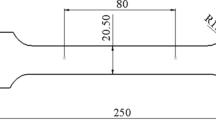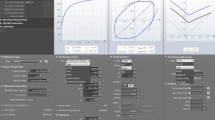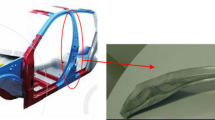Abstract
An accurate prediction of sheet metal deformation including springback is one of the main issues in an efficient finite element (FE) simulation in automotive and stamping industries. Considering tooling design for newer class of high-strength steels, in particular, this requirement became an important aspect for springback compensation practices today. The sheet deformation modeling accounting Bauschinger effect is considered to be a key factor affecting the accuracy of FE simulations in this context. In this article, a rate-independent cyclic plasticity model is presented and implemented into LS-Dyna software for an accurate modeling of sheet metal deformation in stamping simulations. The proposed model uses Hill’s orthotropic yield surface in the description of yield loci of planar and transversely anisotropic sheets. The strain-hardening behavior is calculated based on an additive backstress form of the nonlinear kinematic hardening rule. The proposed model is applied in stamping simulations of a dual-phase steel automotive part, and comparisons are presented in terms of part strain and thickness distributions calculated with isotropic plasticity and the proposed model. It is observed that both models produce similar plastic strain and thickness distributions; however, there appeared to be considerable differences in computed springback deformations. Part shapes computed with both plasticity models were evaluated with surface scanning of manufactured parts. A comparison of FE computed geometries with manufactured parts proved the improved performance of proposed model over isotropic plasticity for this particular stamping application.





Similar content being viewed by others
References
M.A. Ahmetoglu, G. Kinzel, and T. Altan, Computer Simulation for Tool and Process Design in Sheet Forming, J. Mater. Process. Technol., 1994, 46, p 421–441
A.E. Tekkaya, State-of-the-Art of Simulation of Sheet Metal Forming, J. Mater. Process. Technol., 2000, 103(1), p 15–23
H. Darendeliler and B. Kaftanoglu, Deformation Analysis of Deep-Drawing by a Finite Element Method, Ann. CIRP, 1991, 40(1), p 281–284
M. Firat, B. Kaftanoğlu, and O. Eser, Sheet Metal Forming Analyses with an Emphasis on the Springback Deformation, J. Mater. Process. Technol., 2008, 196, p 135–148
M. Firat, Computer Aided Analysis and Design of Sheet Metal Forming Processes, Part III: Die-Face Design, Mater. Des., 2007, 28(4), p 267–279
K. Mattiasson, P. Thilderkvist, A. Samuelson, and A. Strange, Simulation of Springback in Sheet Metal Forming, Simulation of Materials Processing: Theory, Methods and Applications, S.F. Shen and P.R. Dawson, Ed., A.A. Balkema, Rotterdam, 1995, p 115–124
M. Yoshida and U. Uemori, A Model of Large-Strain Cyclic Plasticity and its Application to Springback Simulation, Int. J. Mech. Sci., 2003, 45, p 1687–1702
P. Van Houtte, Application of Plastic Potentials to Strain Rate Sensitive and Insensitive Anisotropic Materials, Int. J. Plast., 1994, 10, p 719–748
Y. Jiang, “Cyclic Plasticity with an Emphasis on Ratcheting,” Ph.D. Dissertation, University of Illinois at Urbana-Champaign, 1993
J. Gau, “A Study of the Influence of The Bauschinger Effect on the Springback in the Two-dimensional Sheet Metal Forming,” Ph.D. Dissertation, The Ohio State University, 1999
L. Geng, “Application of Plastic Anisotropy and Non-isotropic Hardening to Springback Prediction,” Ph.D. Dissertation, The Ohio State University, 2000
R. Hill, Constitutive Modelling of Orthotropic Plasticity in Sheet Metals, J. Mech. Phys. Solids, 1990, 38(3), p 405–417
W.F. Hosford and R.M. Caddell, Metal Forming: Mechanics and Metallurgy, Prentice-Hall, Upper Saddle River, NJ, 1993
C. Vial, R.M. Caddell, and W.F. Hosford, Yield Loci of Anisotropic Sheet Metals, Int. J. Mech. Sci., 1983, 25, p 899
J.C. Simo and T.J.R. Hughes, Computational Inelasticity, Springer-Verlag New York Inc., New York, 1998
J.L. Chaboche and G. Rousselier, On the Plastic and Viscoplastic Constitutive Equations, Part I: Rules Developed with Internal Variable Concept, J. Pressure Vessel Technol., 1983, 105, p 153–158
ASTM Standard E8-01, Standard Test Methods for Tension Testing of Metallic Materials, ASTM International, West Conshohocken, PA, 2001
Acknowledgments
This study was performed as a part of the research project supported by Coskunoz Holding and Turkish Scientific and Technological Research Council (TUBITAK). Authors thank to Mr. Aydin Kuntay of Bias Engineering for providing the technical material and supporting the use of the LS-Dyna in this study. Also helps of technical staff of Coskunoz-Metalform are gratefully acknowledged.
Author information
Authors and Affiliations
Corresponding author
Rights and permissions
About this article
Cite this article
Firat, M., Karadeniz, E., Yenice, M. et al. Improving the Accuracy of Stamping Analyses Including Springback Deformations. J. of Materi Eng and Perform 22, 332–337 (2013). https://doi.org/10.1007/s11665-012-0257-5
Received:
Revised:
Published:
Issue Date:
DOI: https://doi.org/10.1007/s11665-012-0257-5




